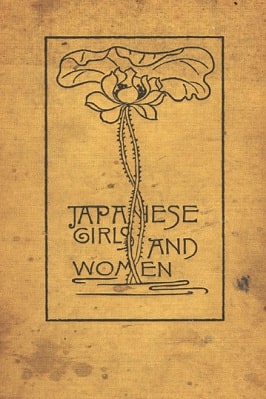
| Book Title | Japanese Girls And Women |
| Book Author | Alice Mabel Bacon |
| Total Pages | 143 |
| Book Views | |
| Language | English |
| Book Download | PDF Direct Download Link |
| Get Hardcover | Click for Hard Similar Copy from Amazon |
Japanese Girls and Women, by Alice Mabel Bacon
JAPANESE GIRLS AND WOMEN
Childhood.
To the Japanese baby, the beginning of life is not very different from its beginning to babies in the Western world. Its birth, whether it be girl or boy, is the cause of much rejoicing.
As boys alone can carry on the family name and inherit titles and estates, they are considered of more importance, but many parents’ hearts are made glad by the addition of a daughter to the family circle.
As soon as the event takes place, a special messenger is dispatched to notify relatives and intimate friends, while formal letters of the announcement are sent to those less closely related.
All persons thus notified must make an early visit to the newcomer, in order to welcome it into the world, and must either take with them or send before them some present.
Toys, pieces of cotton, silk, or crêpe for the baby’s dress are regarded as suitable; and everything must be accompanied by fish or eggs, for good luck. Where eggs are sent, they are neatly arranged in a covered box, which may contain thirty, forty, or even one hundred eggs.[1]
The baby, especially if it be the first one in a family, receives many presents in the first few weeks of its life, and at a certain time, the proper acknowledgment must be made and return presents sent. This is done when the baby is about thirty days old.
[1] All presents in Japan must be wrapped in the white paper, although, except for funerals, this paper must have some writing on it, and must be tied with a peculiar red and white paper string, in which is inserted the noshi, or bit of dried fish, daintily folded in a piece of colored paper, which is an indispensable accompaniment of every present.
Both baby and mother have a hard time of it for the first few weeks of their life. The baby is passed from hand to hand, fussed over, and talked to so much by the visitors that come in, that it must think this world a trying place.
The mother, too, is denied the rest and quiet she needs and wears herself out in the excitement of seeing her friends, and the physical exercise of going through, so far as possible, the ceremonious bows and salutations that etiquette prescribes.
Before the seventh day, the baby receives its name.[2] There is no special ceremony connected with this, but the child’s birth must be formally registered, together with its name, at the district office of registration, and the household keeps the holiday in honor of the event.
A certain kind of rice, cooked with red beans, a festival dish denoting good fortune, is usually partaken of by the family on the seventh day.
[2] A child is rarely given the name of a living member of the family, or of any friend. The father’s name, slightly modified, is frequently given to a son, and those of ancestors long ago dead are sometimes used.
One reason for this is probably the inconvenience of similar names in the same family, and middle names, as a way of avoiding this difficulty, are unknown.
The father usually names the child, but some friend or patron of the family may be asked to do it. Names of beautiful objects in nature, such as Plum, Snow, Sunshine, Lotos, Gold, are commonly used for girls, while boys of the lower classes often rejoice in such appellations as Stone, Bear, Tiger, etc.
To call a child after a person would not be considered any especial compliment.[*3]
The next important event in the baby’s life is the miya mairi, a ceremony which corresponds roughly with our christening. On the thirtieth day after birth,[*4] the baby is taken for its first visit to the temple.
For this visit great preparations are made, and the baby is dressed in finest silk or crêpe, gayly figured,–garments made especially for the occasion.
Upon the dress appears in various places the crest of the family, as on all ceremonial dresses, whether for young or old, for every Japanese family has its crest.
Thus arrayed, and accompanied by members of the family, the young baby is carried to one of the Shinto temples, and there placed under the protection of the patron deity of the temple.
This god, chosen from a great number of Shinto deities, is supposed to become the special guardian of the child through life. Offerings are made to the god and to the priest, and a blessing is obtained; and the baby is thus formally placed under the care of a special
To read more about the Japanese Girls And Women book Click the download button below to get it for free
Report broken link
Support this Website
Click here to join our Telegram group for new Books